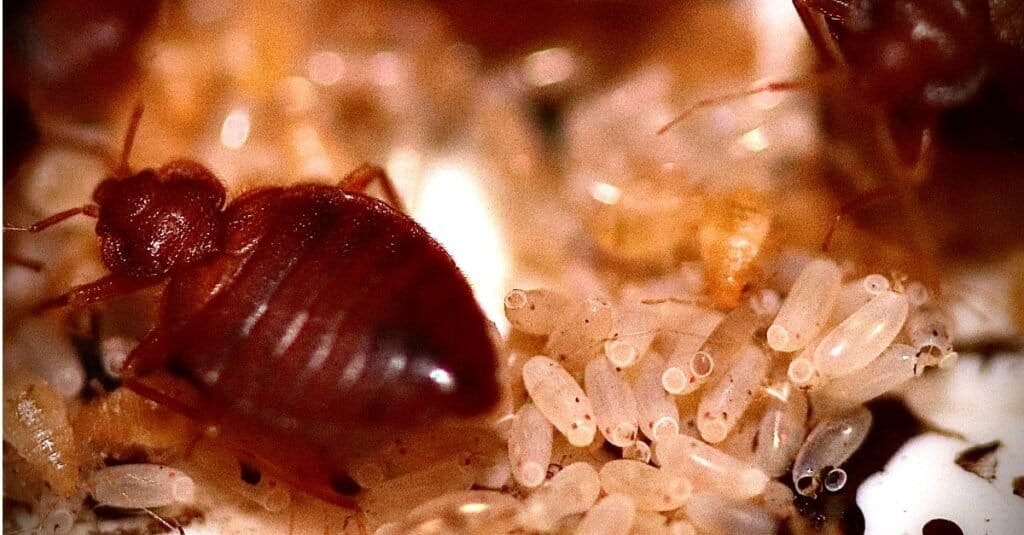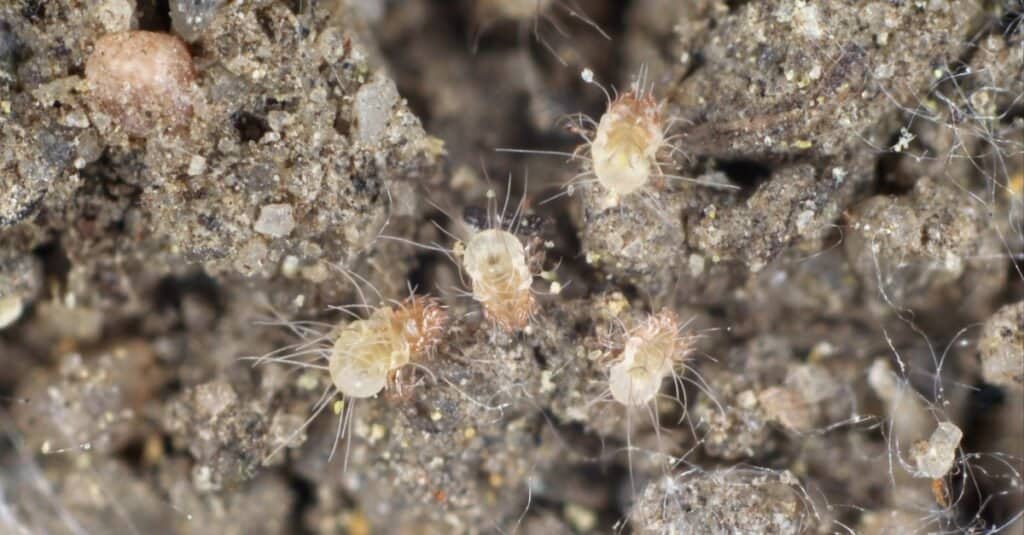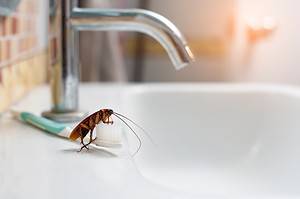The bed bug and the dust mite are both unpleasant critters with some similarities. They’re disgusting house bugs, happily taking up residence in our textiles and furniture. But, more so, they famously love getting comfy in our mattresses, bed frames, and box springs.
While not necessarily dangerous, these animals can wreak havoc on our health and mental well-being. One species are horrific bloodsuckers. The other maintains a diet of dead skin. Nocturnal by nature, they bite and suck on their diet from humans and animals, especially as we rest.
The insects don’t spread diseases but can cause rashes that increase the chance of secondary skin infections. Symptoms of the bites include red areas and slight swelling. The thing is, how a victim reacts to the bites can differ. Some do not react at all.
Signs of a bed bug or dust mite infestation can be egg cases, fecal stains, and shed skin in the cracks and crevices in or around the bed.
The general public often mixes up these creatures, but the duo has quite a few differences. Read on to learn more about the dust mite and the bed bug in-depth, including facts about the identification, treatment, prevention, and detection of signs of their presence.

©iStock.com/selvanegra
Comparing Bed Bugs vs Dust Mites
One of the most noticeable differences between the dust mite and the bed bug is size.
Bed Bugs
Bed bugs come in at less than 0.28 inches. Some can be as small as 0.19 inches. That makes these pests about the size of a pinky fingernail or an apple seed in appearance.
Young bed bugs (nymphs) are originally translucent yellow but turn red once they begin feeding on blood. They grow to be a brownish color with oval, flat frames. But, again, they turn a deep red color and elongate after a good feed.
Dust Mites
The dust mite is only one-tenth the size of the bed bug. Dust mites are not visible to the human eye. Their appearance is only visible under a microscope. These nasties only grow between .004 and 0.157 inches.
Dust mites are a translucent white color and are globular in shape.
The Biggest Difference of Them All!
Believe it or not, the dust mite is not an insect. They have eight legs and no antennae. The features make them a member of the arachnid class, a cousin of the spider.
Bed bugs belong to the insect class. So, as is normal in this group, they have six legs and antennae.
For a closer look at the differences between the pests, check out the following table.
| Bed Bugs | Dust Mites | |
|---|---|---|
| Size | Between 0.19 inches and 0.28 inches | Between .004 and 0.157 inches |
| Habitat | Bed bug infestations are everywhere. From office buildings and homes to hotels and public transportation. Excellent hitchhikers, they end up in beds, furniture, baseboards, walls, etc. | While dust mites can end up in beds and environments similar to bed bug behavior, dust mites also lean towards carpeting, curtains, and fabric-covered furniture. Another identification is they like dark areas where dust accumulates. |
| Lifespan | The facts are they live between two and four months. Under ideal circumstances, bed bugs can survive up to a year. Adults and older nymphs can keep it moving for months without getting a blood meal. | Dust mites go through five stages in the life cycle, going from egg to adult. The adult can live up to get weeks after the cycle completes. |
| Class | Bed bugs belong to the insect family. | Dust mites are spiders. |

©iStock.com/Matteo Lanciano
Dust Mite Bites vs Bed Bugs Bites
When it comes to sleeping in a hotel, someone else’s home, or on any older mattress, there’s a fear that can arise among many folks. Could I be bitten by bed bugs or dust mites? When comparing dust mite bites vs bed bugs, there’s actually a big difference.
Dust mites are incapable of biting humans, as in, inflicting a bite that breaks the skin. Dust mites can crawl on a human’s skin, feed on dead skin cells, irritate the skin, and even bring about an allergic reaction in an individual which may result in a rash.
However, with bed bugs, it’s quite the contrary. A bed bug can physically bite a person, leaving a mark that can be compared to a mosquito or flea bite. Bed bugs feed on blood, so the bites may leave scabs as well. The bite marks may be random or run in a line across the skin. These marks may not affect a person much, but in some cases can cause allergic reactions leading to inflamed bites, itching, swelling, and more.
What’s also unnerving is that bed bugs inject a victim with an anesthetic and an anticoagulant, preventing the said victim from feeling the bite. In essence, you could be bitten all night without realizing a thing is wrong. Below are some more detailed facts comparing dust mite bites vs bed bugs, as well as other information.
Dust Mites vs Bed Bugs: Lifespan

Dust mites and bed bugs are two common household pests that can cause discomfort and health problems for humans.
©Tomasz Klejdysz/Shutterstock.com
Dust mites and bed bugs are two common household pests that can cause discomfort and health problems for humans. While they are both small and difficult to detect, they have distinct differences in terms of lifespan.
Dust mites are microscopic creatures that thrive in warm and humid environments, such as bedding, carpets, and upholstery. They feed on dead skin cells and other organic matter and can cause allergic reactions in some people. The lifespan of a dust mite is relatively short, ranging from two to four months.
Despite their short lifespan, dust mites can produce hundreds of eggs during their lifetime, which can hatch into new mites and continue the cycle of infestation. Dust mites are also capable of surviving in harsh environments for extended periods, making them difficult to eliminate entirely.
Bed bugs, on the other hand, are small, reddish-brown insects that feed on the blood of humans and animals. They can be found in mattresses, furniture, and other areas where people sleep or rest. Bed bugs can cause skin irritation, allergic reactions, and mental distress, and can be notoriously difficult to eliminate.
The lifespan of a bed bug varies depending on environmental factors and the availability of food sources. Generally, bed bugs can live for several months to a year or more. During their lifetime, female bed bugs can lay hundreds of eggs, which hatch into nymphs and grow into adult bed bugs.
6 Key Differences Between Bed Bugs and Dust Mites
Here are six facts about behavior and treatment that separate these pests.
- Bed bugs are parasites, one of the species that do not transmit diseases. Their bites can have no impact at all or instill serious allergic reactions.
- Dust mites manage a diet of dead skin cells. The bugs find food on floors and in carpets, but they’re not incapable of landing on the skin to feed.
- The lifecycle of the dust mite is egg, larva, protonymph, tritonymph, and adult. The bed bug stage starts with the egg before going through four instar nymph stages and finally adulthood.
- Bed bug bites result in severe itching, hives, redness, or blisters. Treatment includes washing the area and applying anti-itching solutions. If it doesn’t get better, see a doctor.
- Dust mites can promote allergic reactions. Doctors will use skin pricks or blood tests to see if your symptoms are mite-related. Treatment will include shots or immunotherapy.
- Prevention: Dust mites can be impossible to get rid of. Clean bedding and use mattress and pillow covers. (This will also work against bed bugs). Bed bugs will need the big guns. Heat treatments may work. You can also stop infestation with chemicals like pyrethroids. You may need to turn to an exterminator.
The photo featured at the top of this post is © Tomasz Klejdysz/Shutterstock.com
FAQs (Frequently Asked Questions)
How do I know if I have bed bugs or dust mites?
Dust mites are too small in appearance for the human eye. Signs of dust mites will suffer symptoms like eczema, nasal issues, watery eyes, or bug bites. Signs of bed bugs include unexplained streaks of blood. You may be smashing bugs in your sleep.
What are the similarities between dust mites and bed bugs?
Despite what seems like similarities, they are different species. Dust mites belong to the arachnid class. Bed bugs are insects.
Are dust mites worse than bed bugs?
Some argue mites are less annoying than bed bugs. You can stop a dust mite infestation simply by keeping surfaces (sheets and blankets) clean. They eat dead skin. Bed bugs are harder to get rid of and diet on blood.
Do bed bugs come from dust mites?
No, they are completely separate species.
Can you feel dust mites crawling?
No, they do not create that creepy-crawly sensation most insects do.
What kills dust mites and bed bugs?
There’s easy prevention for dust mite infestation. Wash your beddings in temps of at least 130 degrees Fahrenheit. To get rid of bed bugs, steam slowly along the tufts, folds, edges, and corners of mattresses, sofa seams, bed frames, and other places where the nuisances hide.
Thank you for reading! Have some feedback for us? Contact the AZ Animals editorial team.






